The second of two single day Late Autumn Tours today in North Norfolk. We actually saw the sun for a while first thing, the first time for over a week! It did then cloud over again, but it was not as misty as it has been and again it stayed dry and was fairly still and mild. Not bad weather to be out birding in.
We started the day at Holkham. Parking up on Lady Anne’s Drive, it was clearer today and we could see more birds out on the grazing marshes. Lots of Wigeon, several Greylags, a single Curlew and a couple of Lapwings. A couple of Great White Egrets flew round further back.
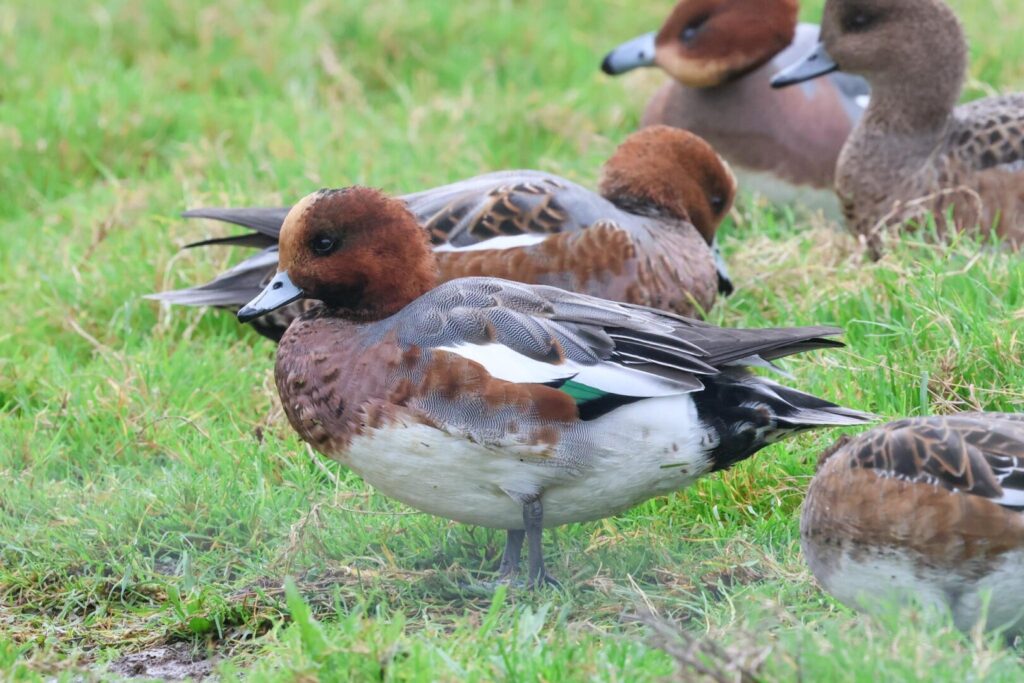
We got the scope on a pale Common Buzzard perched in the top of a bush, while a Marsh Harrier quartered over the reeds beyond. A couple of Jays flew back and forth on the search for acorns again. A small group of five Pink-footed Geese flew low past us calling.
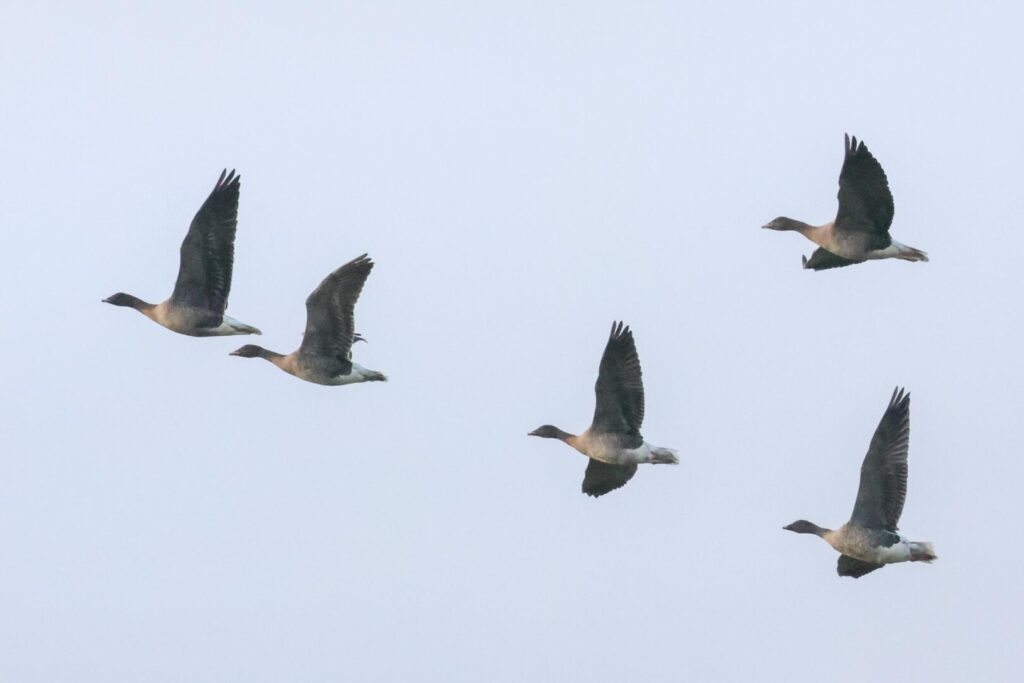
Through the trees and out onto the saltmarsh beyond, the small group of Brent Geese were feeding out in the vegetation again. Nice views through the scope in the early morning sunshine. There seemed to be fewer migrants on the move today but we did spot just a couple of Starlings heading west. A few Skylarks flew over calling.
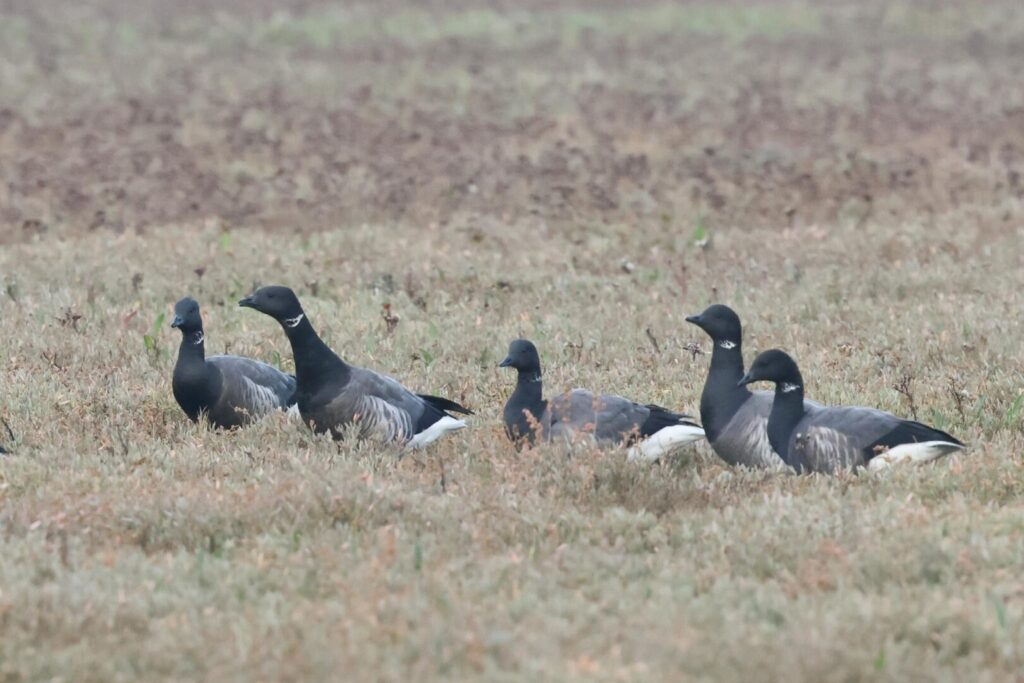
As we arrived at the cordon, we could see someone with a scope down at the far end, where the Shorelarks have been favouring, staring intently. We walked on and could see that the Shorelarks were quite close to the path. The low morning sun catching their yellow faces, they looked stunning. We got the scope on them but before everyone could get a look they took off. As they did yesterday, we watched as they disappeared off towards Wells.
Looking round now, we spotted a lone White-fronted Goose in the cordon too. Odd to see one here. Possibly a fresh arrival in from the Continent, coming here for the winter, it looked exhausted. It settled down in the vegetation and went to sleep. We heard Pink-footed Geese calling and looked up to see an untidy skein of about 80 coming in high over the dunes. More birds arriving here for the winter.
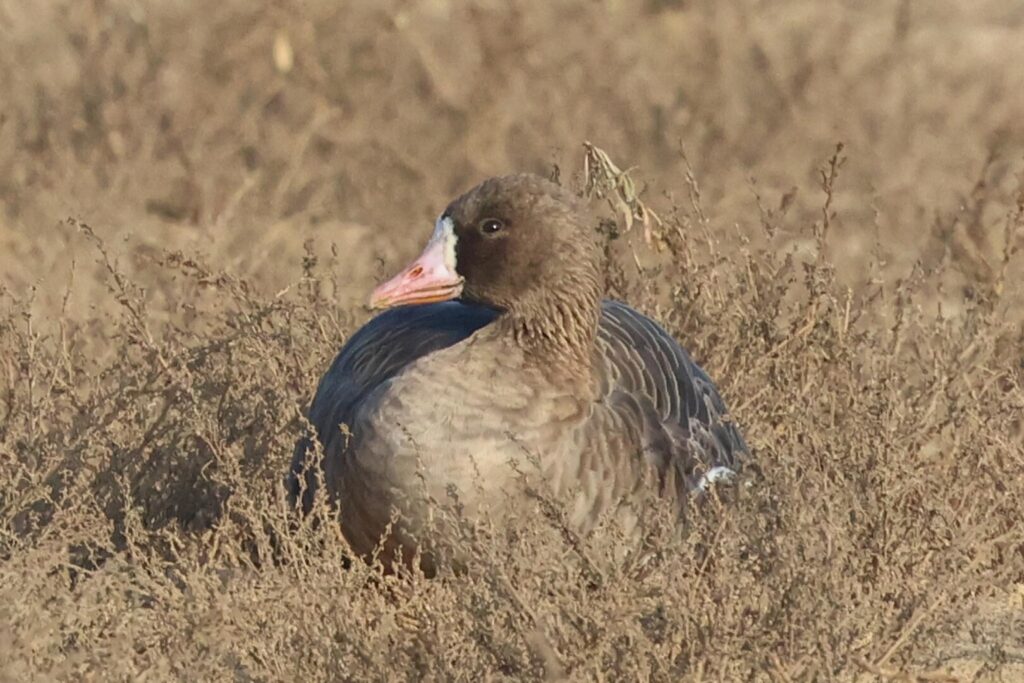
We walked on round the end of the cordon and out onto the beach. The first thing we noticed were several Gannets diving offshore. They kept flying up, circling round, folding their wings back and plunging back into the water. Impressive to watch. There were still 1,000 or more Common Scoters rafting offshore, but despite the lack of mist this morning, they were still just to far out to pick out anything different with them apart from one or two Great Crested Grebes. Another flock of Pinkfeet flew past over the sea calling.
Scanning over the water, we could see the Great Northern Divers away to the west again. We walked down along the beach to try to get a closer look. As we passed, we checked where the Snow Buntings had been yesterday but there was no sign this morning. With the improvement in the weather and the sunshine, there were lots more people out walk their dogs today, more disturbance for beach feeding birds.
The tide was further out today, so we had a better view of the sea from the beach. We could see that the breeding plumage Great Northern Diver was swimming back east towards us. It was rather far out but seemed to be coming slightly closer in, so we walked down to the shore to try to get a better look. But by the time we got down to the edge of the water it was going back further out again. The paler Great Northern Diver was still offshore, but diving all the time at first. After a while, it stopped to preen and we could get the scope on it, but it too started to drift further out now.
A single Sanderling was running along the shore, coming straight towards us. It almost ran right up to us but at the last minute, it seemed to notice us, stopped and then ran off back the other way. A minute or so later, it decided to fly past us instead. As we walked back up the beach, a couple of Red-throated Divers were flying round offshore.
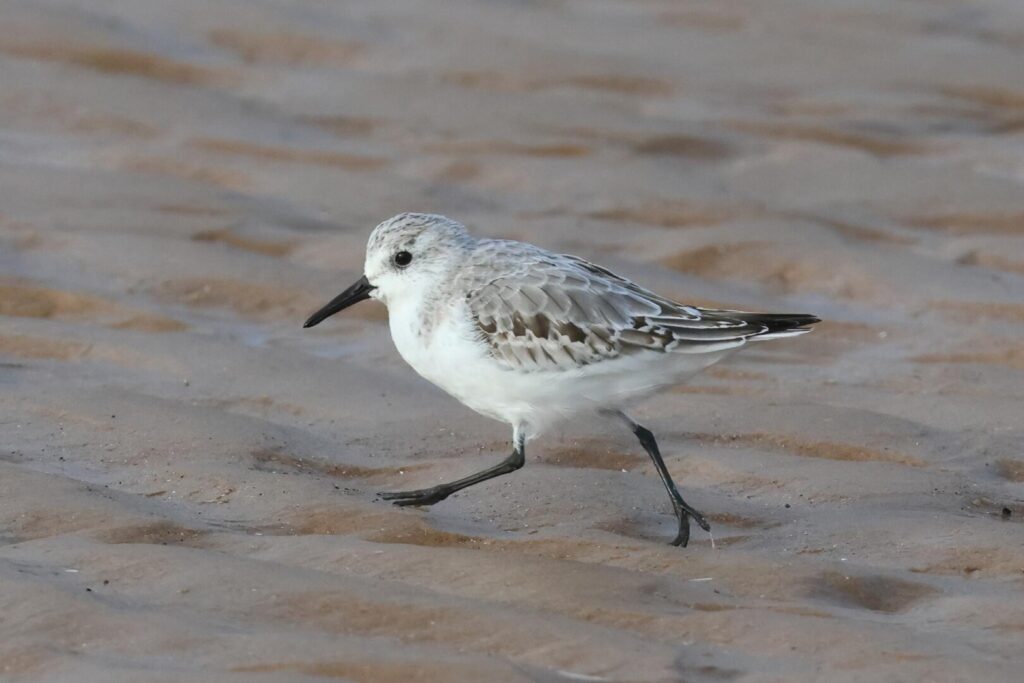
We decided to head back round to the cordon to see if the Shorelarks had returned. As we rounded the end of the dunes, we noticed movement ahead of us, two Snow Buntings were on the sand. We stopped and they ran back to a line of vegetation washed in by the tide and started to feed. Great views through the scope now. Another of our winter visitors which is starting to return now.
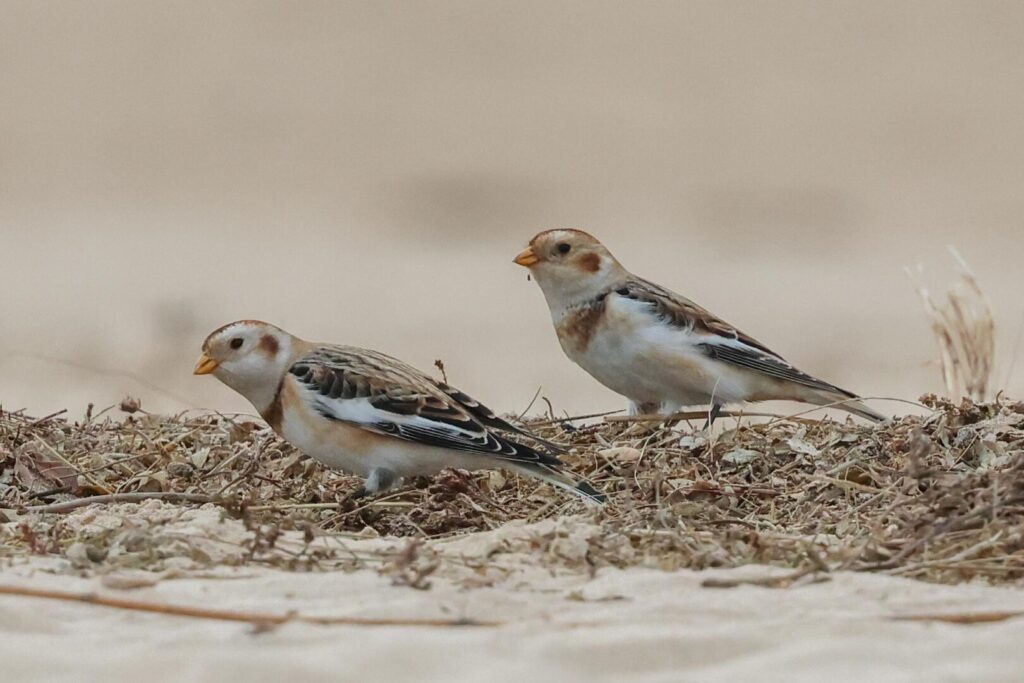
Scanning from the far end of the cordon, the White-fronted Goose had disappeared. Presumably, after a rest it had recovered and flown off. There was no sign of any Shorelarks either. Never give up. They can be very elusive in the dips in the ground and the vegetation, so as we walked on we kept scanning. We had almost given up hope when we found them in creeping around in the back of the cordon. Some of the group had only seen them flying off earlier so it was good that we were able to get some more prolonged views in the scope now.
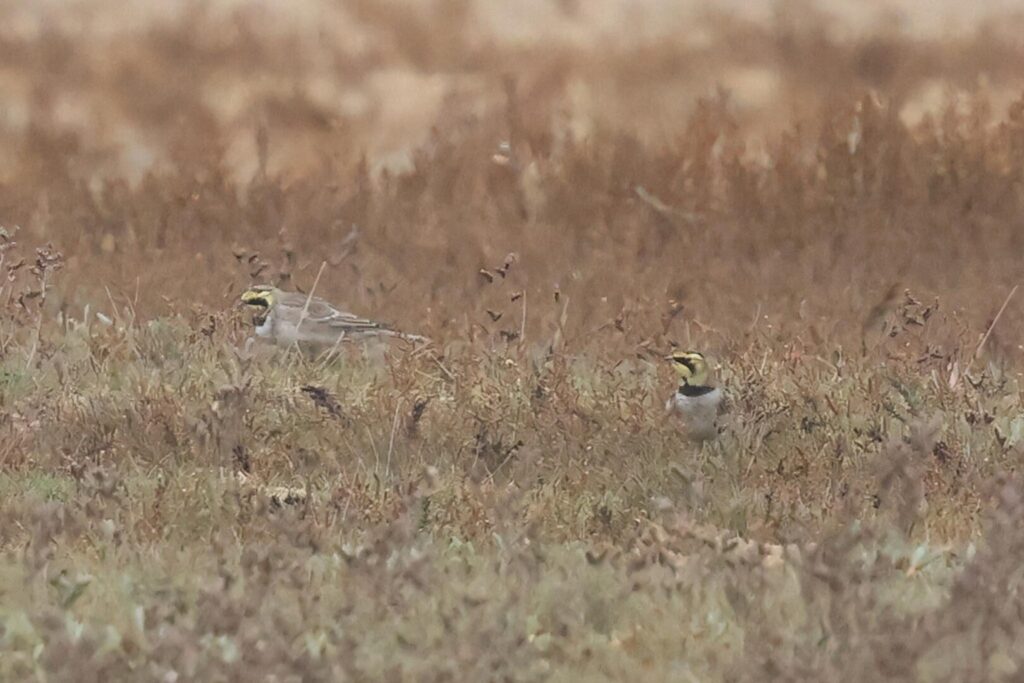
As we walked back, a large flock of Linnets flew across over the saltmarsh. Hopefully there will not be too much disturbance and they can settle here to feed.
Back through the pines, we headed over to The Lookout to use the facilities and for some of the group to get a coffee. There were a few cows still out on the grazing marsh beyond and we looked over just in time to see a Cattle Egret fly in and land on the back of one of them. A classic Cattle Egret view. A couple more dropped in out of view and then, as we walked back to the Drive, another three more Cattle Egrets flew in. A Grey Heron was standing in amongst the cows too, pretending to be an oversized Cattle Egret!
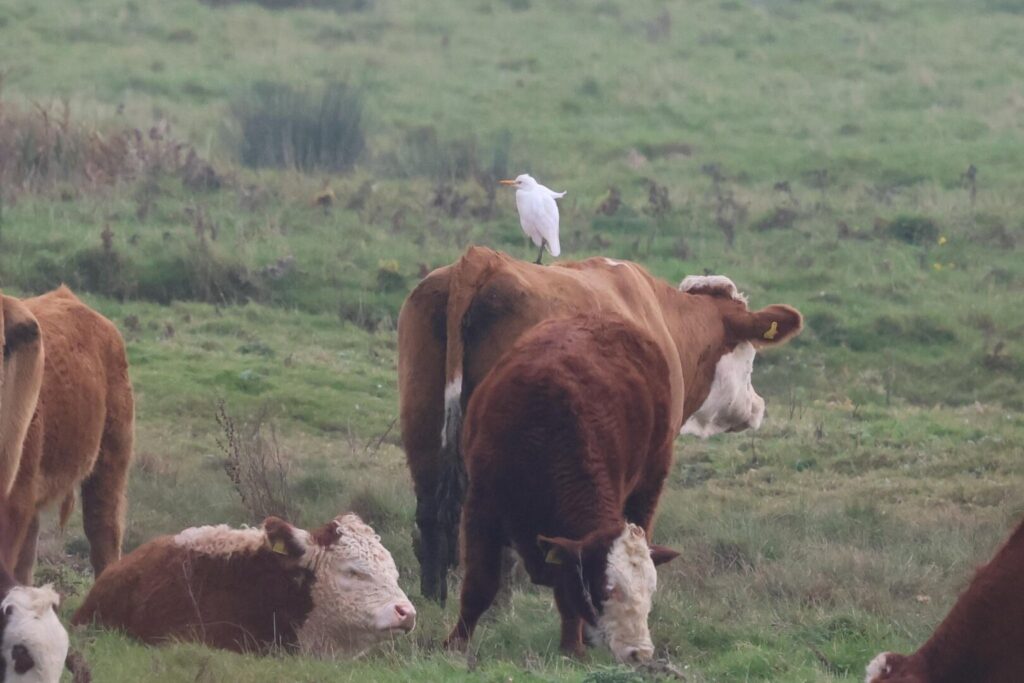
After our coffee break, we walked back to the minibus and made our way west along the coast road. We turned inland up to Choseley. The Kestrel was in the same place in the hedge again, before flying over the road in front of us. There were still a few Blackbirds, a couple of Redwings and the flock of Linnets.
As we drove on down to the corner, we could see one of the gamekeepers driving round the edges of all the fields in a land rover. No surprise then, that when we arrived there were fewer birds! Two Red Kites and two Common Buzzards chased round over the cultivated beet field opposite. A flock of Pink-footed Geese flew in calling, but didn’t land. The cultivating had done its job and made the field unattractive for the geese to feed here.
A few Yellowhammers and Chaffinches drifted back in and eventually we had views of them perched up in the hedges. Two Redwings flew in too but landed on the branches where they were were hard to see. Another flew round overhead, flashing its orange (rather than red!) underwings. Presumably the Woodpigeons had been flushed by the gamekeeper too and as they flew back in we could see several Stock Doves with them.
We could see lots of Red-legged Partridges in the edges of the fields today, and hiding in the maize strip opposite. Ready to be shot. The gamekeeper drove out of the fields right round past where we were standing, so we stood back by the minibus to let him out. He deliberately did not even acknowledge our presence – a frontrunner for the Most Miserable Gamekeeper of the Year Award?
It was time for lunch, so we made our way down to Titchwell and made use of the picnic tables. Afterwards, we headed out for a quick look along Fen Trail. It didn’t look like the Tawny Owl was even in its usual tree today. Round at Patsy’s Reedbed, there were a few Coot, Moorhen, Gadwall and two Mute Swans. Two Little Grebes were chasing in and out of the reeds in the near corner. We only had a quick look but there was no sign of the Bittern again.
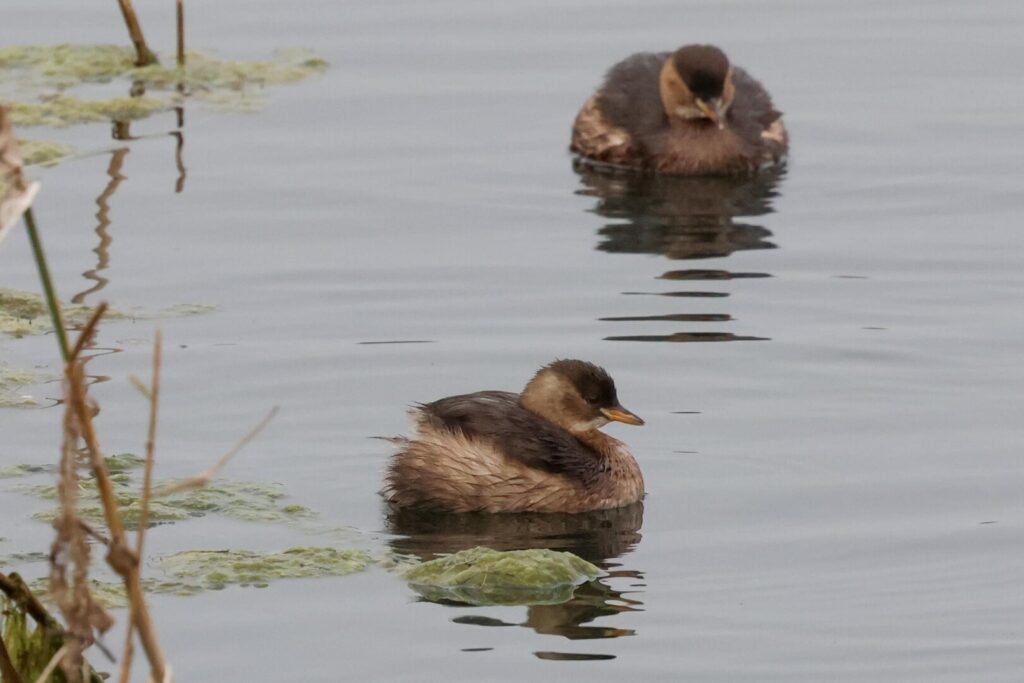
A distant Marsh Harrier was hunting out over Brancaster dunes, then another flew in over the reedbed and landed in a bush. We got it in the scope for a closer look. As we made our way round on Meadow Trail, a Muntjac was out on the orchid meadow and looked up nonchalantly as we walked past. They have a particular taste for the Southern Marsh Orchids but thankfully there are no orchids to eat now. Another Marsh Harrier circled round over the reeds just beyond. A flock of tits was feeding in the sallows and several Long-tailed Tits flew across the path in front of us.
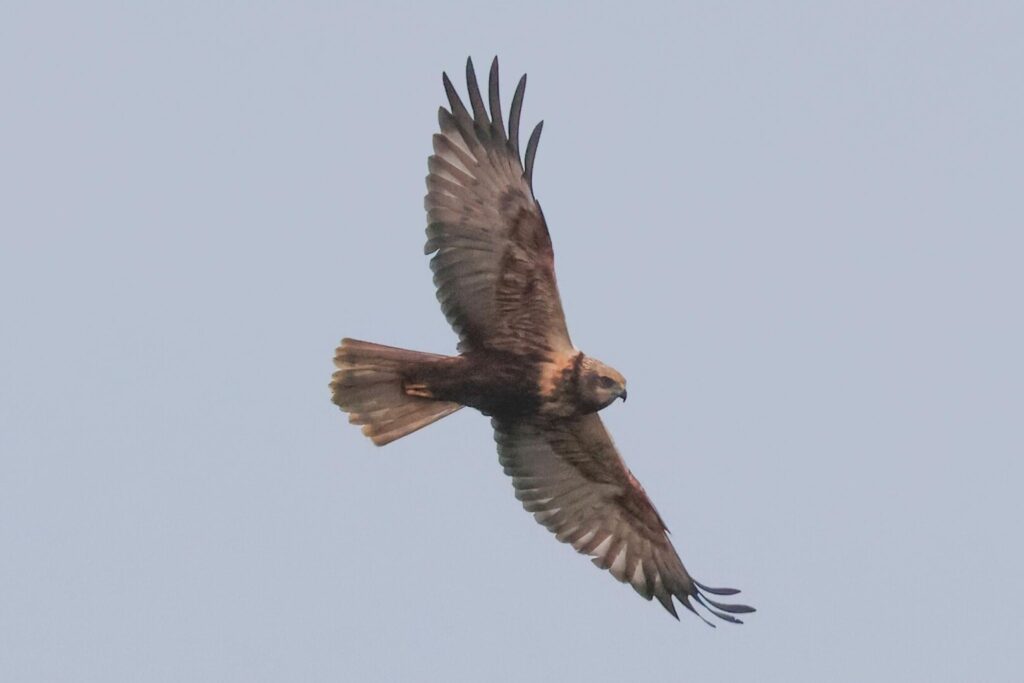
Back out on the main path, we walked back a short way to scan the ditch. There was at least one Moorhen and then one of the group saw a shape disappear into the undergrowth where the Water Rail had been the other day. We waited a minute but it didn’t come out again. One that got away.
As we came out of the trees. A smart male Marsh Harrier was out over the Thornham reedbed, and a Stonechat was flycatching from the brambles in front. The reedbed was quiet again, but the Coot, Gadwall and single Tufted Duck were all still on the reedbed pool.
Continuing to to the Freshmarsh, we couldn’t see any sign of Spoonbills today. And one of the group was particularly hoping to see one. We asked a couple of the volunteers but they hadn’t seen any either. Could they have all departed overnight? It didn’t seem particularly likely.
As we walked up to the bund, a Water Rail squealed from the reeds. There was a nice selection of ducks again, lots of Shoveler and Teal. We got the scope on a Gadwall to admire its intricate plumage and a Pintail upending out on the water.
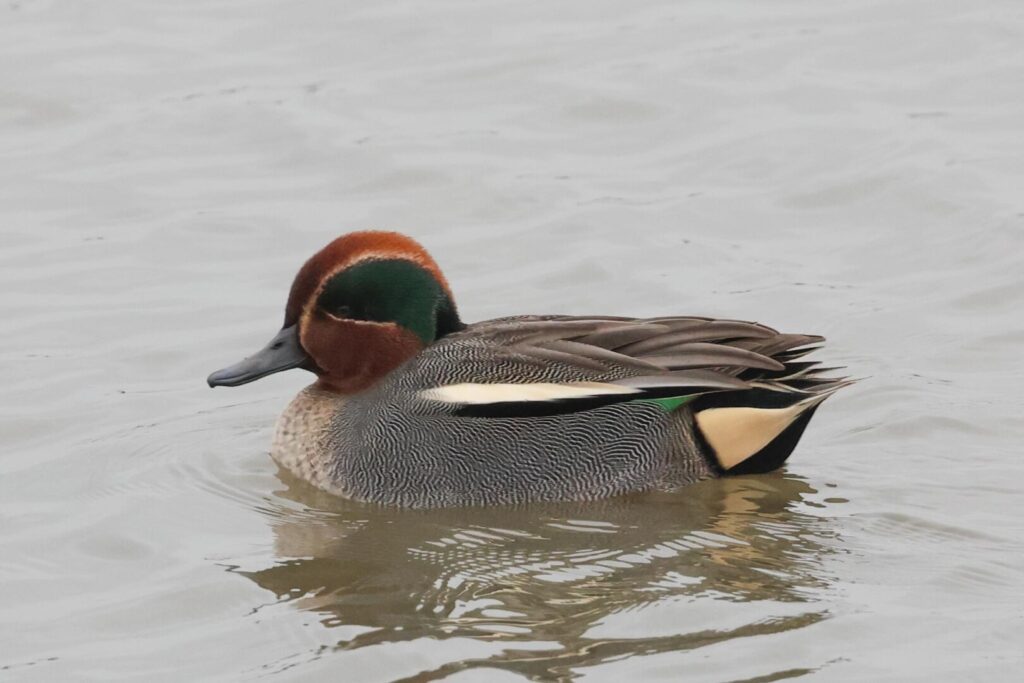
The flock of Golden Plover were all gathered in the shallow water again, along with a few Ruff and Dunlin. A single Common Snipe was feeding in between the Lapwings gathered on the edge of the bund. There was no sign of it at first, but then the escaped Black-winged Stilt appeared from behind one of the islands. Several small flocks of Linnets flew in and out.
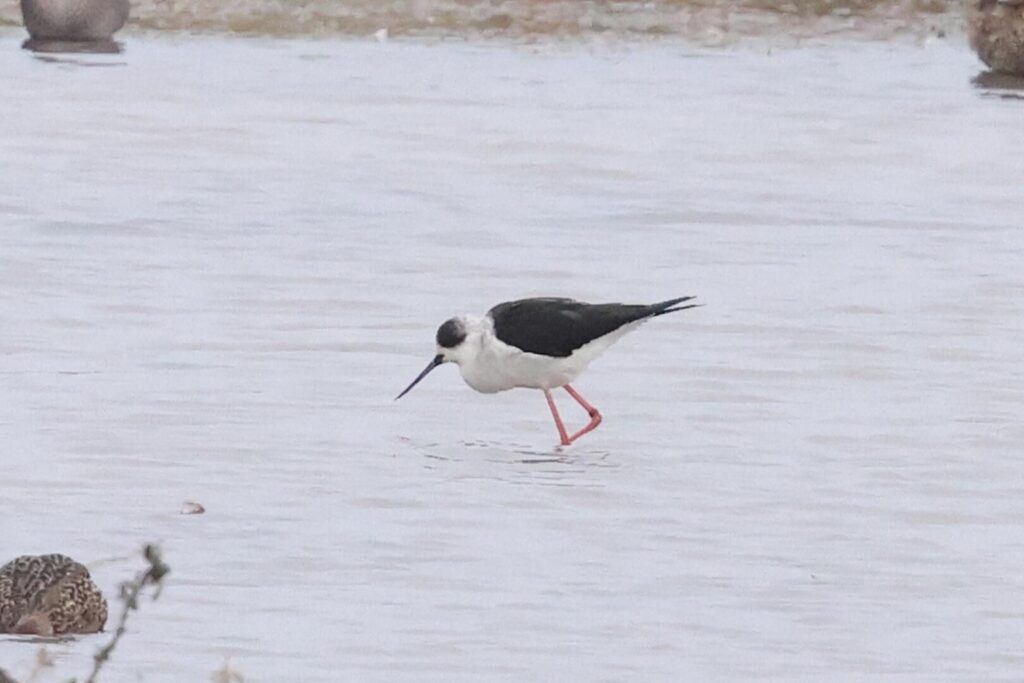
We continued on out towards the beach. The Curlew was in its usual place in the channel on Volunteer Marsh but flew off as we walked along. A Rock Pipit flew over the path calling. Scanning the muddy channel at the far end, we could see several Black-tailed Godwits and Redshanks further back.
Out at the Tidal Pool, the first bird which caught our eye were two Greenshank roosting at the back. Their white underparts really stood out, despite the fact that the light was already starting to go. One woke up and flashed its slightly upturned bill. There were a few Dunlin here as well, plus a Ringed Plover and Grey Plover too. A couple of Black-tailed Godwits were feeding right next to the path and a single Bar-tailed Godwit was a little further back. Not alongside each other, but still nice to compare, looking back and forth between them.
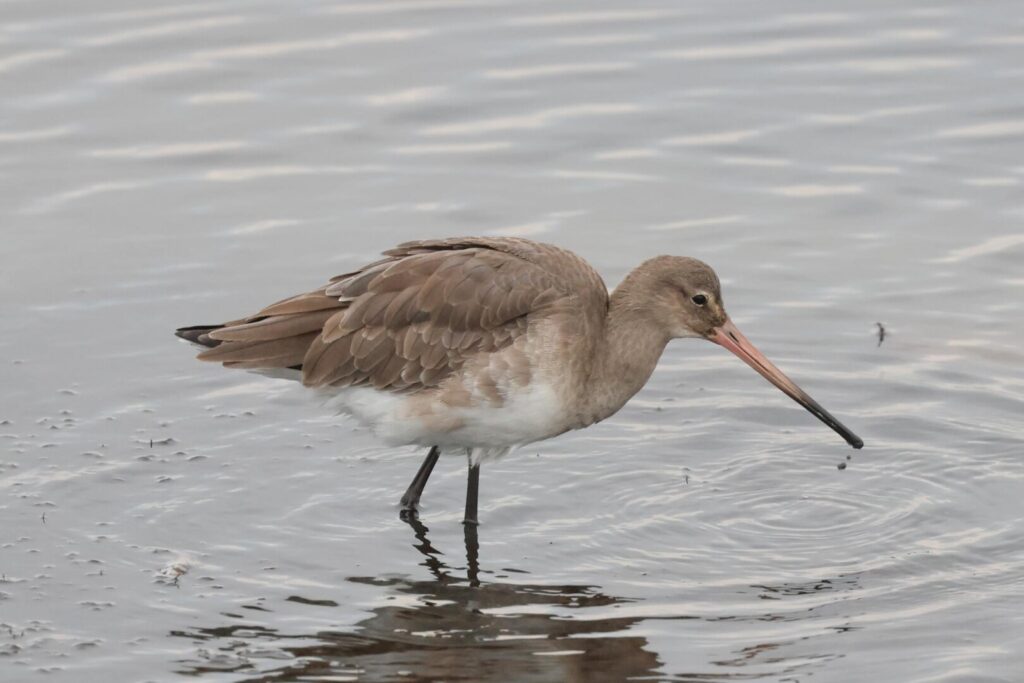
Out at the beach, there was less disturbance today – no dog running around on the loose chasing off all the birds. There were lots of Oystercatchers out on the sand, a single Turnstone, several Sanderlings and more Bar-tailed Godwits a little further along.
We had seen warned at the Visitor Centre and by some of the volunteers on the way out too that the sea was quieter today. There were a couple of Great Crested Grebes offshore and a Red-throated Diver which dived and completely disappeared. We eventually found a few Goldeneye and a single Red-breasted Merganser flew past.
A flock of 14 Snow Buntings flew past right in front of us and landed on the beach just to our right. They didn’t settle though and quickly flew off back west. Another large skein of Pink-footed Geese flew in calling.
As we walked back, something spooked the Golden Plover which flew up and whirled round. As we came up over the low bank by the Parrinder path, we could see along the path and a Sparrowhawk was perched on one of the benches. It saw us too and flew off low over the reeds, skimming up and just over the roof of Island Hide.
We were not convinced the Spoonbills would have left us so there was one last thing to try – perhaps they might come back in to roost. Sure enough, there they were, five of them back on the Freshmarsh. They were a little distant on the far compartment and it was starting to get dark, but we had a good view in the scope. Where had they been all day? Probably feeding out of view out on the saltmarsh.
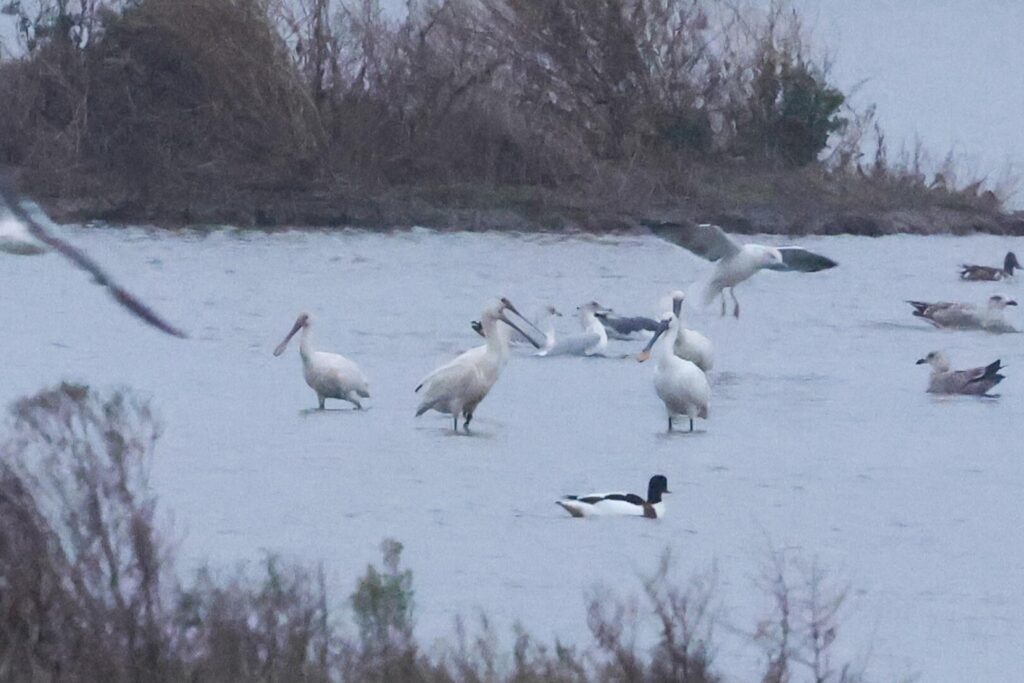
Lots of gulls were gathering out on the water, mainly Herring Gulls and Lesser Black-backed Gulls. We scanned quickly through, and one stood out with its unmarked persil-white head and mantle which was distinctly darker than a Herring Gull but not slaty-grey like a Lesser Black-backed Gull. It was an adult Yellow-legged Gull, a nice late bonus.
Walking back towards the reedbed, a succession of singles and small groups of Little Egrets flew over, heading in to roost. There was not much Marsh Harrier activity in the roost again tonight, but we could see one male hunting out over the saltmarsh still. Another flew in and as it had a last circle over the reeds it had a little swoop at the Starlings which were gathering to roost too. A large flock swirled round low over the reeds. It was time to head back before it got completely dark. Another good day of Late Autumn birding.
If you like what you read, you would be welcome to join one of tours – you can see what we have planned on our Tours page here.
















